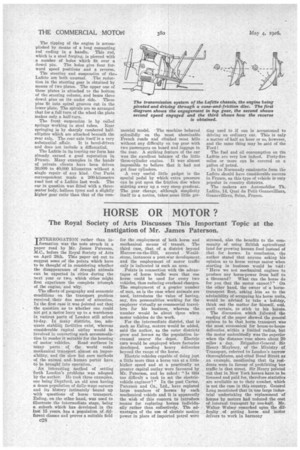HORSE OR MOTOR?
Page 12

If you've noticed an error in this article please click here to report it so we can fix it.
The Royal Society of Arts Discusses This Important Topic at the Instigation of Mr. James Paterson.
INTERROGATION rather than information was the note struck in a paper read by Mr. James Paterson, ALC., before the Royal Society of Arts' on April 28th. This paper set out to suggest some of the points which have to be thought of in considering whether the disappearance of draught animals can be expected in cities during the next year or two, which cities might first experience the complete triumph of the engine,and why. .
The effects of geography and economic conditions on the transport problem received their due meed of attention. In the first case it was Pointed out that the question as to whether one could hot get a motor lorry up to a Warehouse
various parts of London still arises to-day. In many districts, too, adequate. stabling facilities exist, whereas considerable capital otitlay would be involved in converting stich accommodation to renderit suitable for the housing of motor vehicles. Road surfaces in ninny parts of the world make mechanical transport almost an impos and the slow but sure methods of the animal and: human porter have to be brought into operation.
An interesting method of setting forth London's problemswas adopted by the author. Ile took three examples, one being 'Deptford, an old area having a dense population of daily-Wage earners and its history intimately bound up with questions of horse transport. Ealing, 071 the other hand, was used to illustrate the intermediate stage, being a suburb Which has developed in the last 15 years, has a population .of different classes and proves a suitable field
028
for the employment of both horse and mechanical means of transit. The third ease, that of a district beyond Harrow-on-the-Hill, around Wealdstone, instances a post-war development and the employment of motor traffic only is indicated in such an area.
. Points in connection with the advantages of horse traffic were that one horse could be used for _every two vehicles, thus reducing overhead charges. The employment of a greater number of men, as is the case when animals are Used, introduces the value of having, say, five personalities working for the employer virtually as commercial travellers for his business, whereas the number would be about three when motor vehicles do the work.
For the intermediate district, that is such as Ealing, motors would be added, said the author, as the outer districts grew and horses as the population increased nearer the depot. Electric ears would be employed where factories developed, needing heavy deliveries beyond the range of the horse.
Electric vehicles capable of doing just a little more than a horse van at a little higher speed and at a practically no greater capital outlay were favoured by Mr. Paterson, and he asked: "Is this too difficult a task to set the electricvehicle engineer?" In the past Carter, Paterson and Co., Ltd., have replaced large numbers of horses by each mechanical vehicle and it is apparently the wish of this concern to introduce means for replacing horses individually rather than collectively. The advantages_ of the use of electric motive power in place of imported petrol were stressed, also the benefits to the community of. using British agricultural land for growing human food instead of that for horses. in conclusion, the author stated that anyone asking his opinion as to horse versus motor when starting in business would be told: " Have we not mechanical engines to produce any horse-power from half to a thousand? What can the horse do for you that the motor cannot?" On the other hand, the owner of a horsetransport fleet, asking him as to the advisability of scrapping his horse units, would be advised to take a holiday, think out the matter for himself, and, until certain, to stick to his horses.
The discussion which followed the readjng of the paper showed the general opinion to be that horse transport was the most economical for house-to-hotise deliveries within a limited radius, but the motor undoubtedly was the superior when the distance rose above about go miles a day. Ilrigadier-General Sir Henry -Maybury, of the Ministry of Transport, referred to London's narrow thoroughfares, and cited Bond Street as an example, mentioning that its residents were in favour of prohibiting bus traffic in that street. Sir Henry pointed out that in New York horses have to be licensed and paid for, therefore statistics are available as to their number, which is not the case in this country. General Long mentioned that in one large industrial undertaking the replacement • of horses by motors had reduced the cost of internal transport by one-half. Mr. Walter Wolsey remarked upon the difficulty of getting horse and motor drivers to work in harmony
































